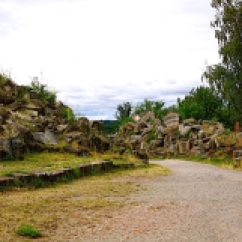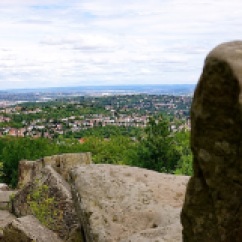This mountain, piled up after World War II from the rubble of the city, stands as a memorial to the victims and a warning to the living.
— plaque at Birkenkopf
Allied bombing raids on Stuttgart during World War II destroyed at least 45% of the city, including nearly all the city center.*
In the mid-1950s, 1.5 million cubic meters of the resulting rubble were moved to a hill in the southwest of the city — raising it by about 40 meters and making it the highest point in central Stuttgart.
This is the Birkenkopf or Rubble Hill, which we visited two weekends ago. It is sometimes also called Monte Scherbelino or Mount Shards.
A wide spiraling asphalt path leads walkers, runners, and cyclists up through the woods that have grown over the debris. At the summit, a semi-circular berm of broken concrete and ornamental stonework forms a terrace or shallow amphitheater facing a spectacular view of the city.
There are many post-WWII rubble hills (aka Schuttberge or Trümmerberge) in Germany. London has some as well, and there’s an interesting essay about this kind of ‘made ground’ (“a sort of spatial redistribution of violence”) here.
I have not been able to find the name of the company or person who directed the design of the Stuttgart hilltop area.
You can watch a beautiful short video of the Birkenkopf from the air here. If you visit Stuttgart, you can reach the site via the no. 92 bus from the Rotebühlplatz U-bahn stop.
To scroll through larger versions of the slides above, click on ‘Continue reading’ below and then on any thumbnail in the gallery.
Roofless walls
Rooks overlook
I told you so
Babbles the brook— Samuel Menashe, from “Ruins“
ADDENDUM: From the Facebook page Birkenkopf-Stuttgart, I learned that the Birkenkopf was designed by Manfred Pahl, a painter and architect working for the city’s Department of Landscape Planning and later with the Verschönerungsverein Stuttgart (beautification association).
There’s an interesting picture of the construction of the hill here.
*Over 4,500 people on the ground and 2,400 Allied aircrew (300 planes) are estimated to have died during the Stuttgart attacks, according to Wikipedia. The city had important industrial resources and several military bases and was a railway hub for the southwest.































A poignant reminder. Beautiful photos, Cindy.
Thank you. It’s a rather moving place to visit. . . especially in light of the news of destruction in places like Syria.
Oh my, that video is so touching…made me tear up. I didn’t realize there was that much destruction there and the hill top has such steep sides. Would love to visit….that would be first on my list!
The guestroom is ready; let us know when!
I didn’t realize how conical (?) the hill is either until I saw the video. I’m looking forward to going back there when the leaves start to change colors.
Interesting post — I learned something!. Some of the architectural detail in the rubble is quite beautiful; it makes a powerful statement to have some of it visible. And, I had no idea that FDR Drive was built on British war rubble.
I thought it was interesting about FDR Drive too. The amount of debris after the war must have seemed an almost insurmountable problem.
I found this fascinating. Thanks for sharing it.